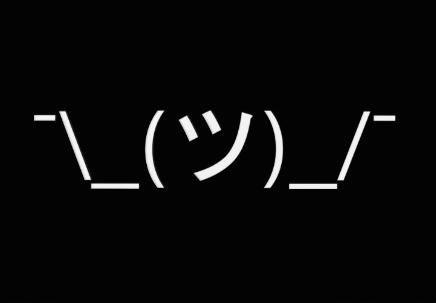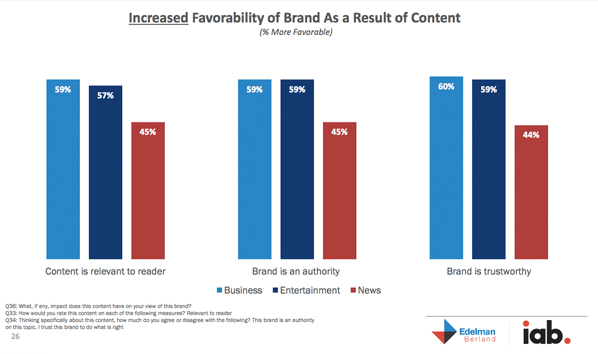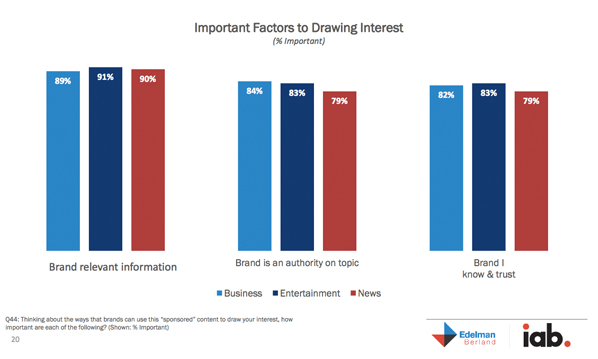
Publishers may be having a love affair with sponsored content, but what about their readers? Three recent studies provide new insights into how readers perceive the native ads that publishers are so enamored of. Turns out, it’s a bit of a mixed bag.
Here are four charts that describe reader sentiment about sponsored content.
Native-ad effectiveness depends on focus of the site
The IAB and Edelman Berland’s July 2014 report on sponsored content shows engagement is higher on business- and entertainment-oriented sites than on general news sites.
The survey of 5000 U.S. Web users found that only 27 percent of general news readers agree that sponsored content adds value to their experience of a site, versus the average of 38 percent for overall respondents across categories.
General news readers consistently saw sponsored content as less favorable and less likely to result in positive brand uplift for the brand or publisher, as this chart shows.
Reputations count on both sides
Native-ad effectiveness depends on the reputation of both the brand and publisher. The IAB’s report shows news publishers see more engagement when they work with familiar and trusted brands. The corollary to this, however, is that native advertising is less effective for generating new brand awareness.
The chart below breaks down which factors are most relevant to readers of different types of content when it comes to native advertising — whether the brand is conveying important information, whether the brand is an authority or whether the brand is simply trustworthy. Turns out, content is still king.
Local attitudes matter
Brits prefer longer headlines than Americans. According to Polar’s U.K. native advertising benchmarks, 60-80-character headlines achieve the best click-through rate, whereas U.S. readers prefer 40-60-character headlines. Another surprising statistic from the same report: Readers outside of London are twice as likely to engage with a native ad versus those in London.
“Engaged time” improves on smartphones and tablets
Native advertising performs better on smartphone and tablet devices compared to the same content on desktop. This is especially true for U.K. users, according to Polar’s benchmarks. A native ad on a smartphone has 64 percent higher click-through rate over desktop (compared to 31 percent globally), according to Polar. U.K. readers spend 3 minutes and 37 seconds on average engaging (measured as time spent) with a native ad on tablet, which is 30 percent higher than the global average. Specifically, U.K. readers have 39 percent higher engagement on tablet over desktop, and 45 percent higher engagement on smartphone over desktop.
Eggheads are less likely to click
A survey of 542 Web users conducted by Contently brought up a few interesting insights on how sponsored content is perceived by readers, broken down by education level. The research suggests better-educated readers are harder to get clicks out of — and gain the trust of — as the following charts demonstrate.
More in Media

NewFronts Briefing: Samsung, Condé Nast, Roku focus presentations on new ad formats and category-specific inventory
Day two of IAB’s NewFronts featured presentations from Samsung, Condé Nast and Roku, highlighting new partnerships, ad formats and inventory, as well as new AI capabilities.

The Athletic to raise ad prices as it paces to hit 3 million newsletter subscribers
The New York Times’ sports site The Athletic is about to hit 3 million total newsletter subscribers. It plans to raise ad prices as as a result of this nearly 20% year over year increase.

NewFronts Briefing: Google, Vizio and news publishers pitch marketers with new ad offerings and range of content categories
Day one of the 2024 IAB NewFronts featured presentations from Google and Vizio, as well as a spotlight on news publishers.









